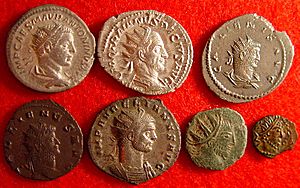Beau Street Hoard facts for kids
Quick facts for kids Beau Street Hoard |
|
|---|---|
| Material | Roman coins |
| Size | 17,577 |
| Created | c. 270s |
| Period/culture | Romano-British |
| Discovered | 2008 Bath, Somerset, England |
| Present location | Roman Baths (Bath) |
The Beau Street Hoard is a huge collection of ancient Roman coins. It was found in Bath, Somerset, a city in England. This amazing discovery is the fifth-largest hoard (a hidden treasure) ever found in Britain. It's also the biggest one found in a British Roman town. The hoard contains about 17,500 silver Roman coins. These coins date from 32 BC to 274 AD. They were found on Beau Street, close to the famous Roman Baths. Bath was once a Roman city called Aquae Sulis.
Contents
Discovering the Ancient Coins
The Beau Street Hoard was found in 2008. Archaeologists from Cotswold Archaeology made the discovery. They were working on a site where a new pool was being built. This site is very close to the Roman Baths.
The coins were found stuck together in a large block. They were hidden under the floor of an old Roman building. The coins were in a small oval pit, about 40 by 30 centimeters (16 by 12 inches) in size. Finding such a large hoard in a town is quite unusual. Most hoards are found in the countryside.
At first, experts thought there might be up to 30,000 coins. Later, they estimated the number was closer to 17,400. The hoard was likely buried around the late 200s AD. Coins from as far back as 32 BC up to 274 AD have been identified.
Saving the Hoard
When the Beau Street Hoard was found, archaeologists believed it had been stored in a wooden box. This box had rotted away over time. The entire block of coins was carefully lifted out. A crane was used to move it as one piece. This allowed experts at the British Museum to study it later.
Scientists at Southampton University used X-rays to look inside the coin block. They found that the coins were stored in several leather bags. Six bags were seen on the X-rays. Two more were found as the coins were being cleaned. Small pieces of the leather bags can still be seen today. The copper in the coins helped protect the leather from rotting completely. Each coin was then cleaned by hand and with chemicals. This helped experts identify them.
What Was Found Inside
The Beau Street Hoard contained different types of Roman coins. These coins were sorted into bags.
- One bag held denarii coins. These coins were made between 32 BC and the 240s AD. The oldest coin was from Mark Antony. It was already 300 years old when it was buried! This bag also had a few radiates from the 250s.
- Four bags contained radiates from the 200s AD. These coins had a high amount of silver.
- Three bags held radiates from the 200s AD that had less silver. These coins were "debased," meaning they had more bronze than silver.
Here is a summary of the coins found in each bag:
| Bag Number | Silver Radiates | Bronze Radiates | Denarii | Total Coins | Date of Latest Coin (AD) |
|---|---|---|---|---|---|
| Bag 1 | 3737 | 44 | 22 | 3803 | 272–274 |
| Bag 2 | 84 | 2947 | 2 | 3033 | 272–274 |
| Bag 3 | 2668 | 97 | 8 | 2773 | 271–274 |
| Bag 4 | 2270 | 6 | 26 | 2302 | 260–269 |
| Bag 5 | 747 | 15 | 13 | 775 | 260–269 |
| Bag 6 | 24 | 0 | 1771 | 1795 | 253–260 |
| Bag 7 | 20 | 386 | 0 | 406 | 272 |
| Bag 8 | 5 | 247 | 1 | 253 | 272–274 |
| Loose coins | – | – | – | 2437 | – |
| Hoard total | – | – | – | 17577 | – |
Displaying the Hoard
The Roman Baths Museum wanted to buy the Beau Street Hoard. They started a campaign to raise the money. The Heritage Lottery Fund helped them with a grant.
In March 2014, the museum received £372,500. This money allowed them to buy the hoard. The Beau Street Hoard was then put on display at the Roman Baths starting in January 2015. Visitors can now see this amazing collection of ancient Roman coins.
Images for kids



